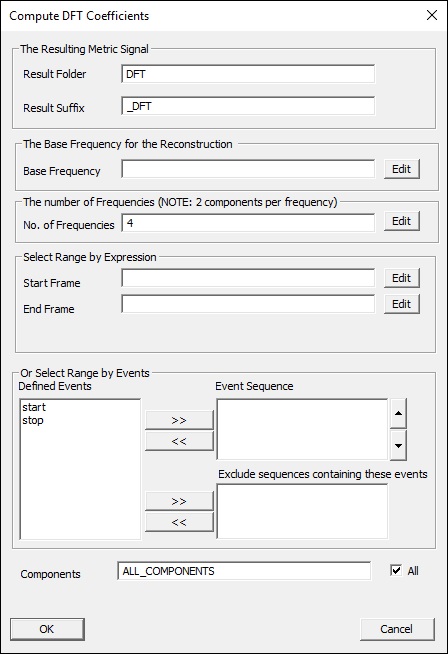Table of Contents
Metric Compute DFT Coefficients
Overview
Metric Compute DFT Coefficients is used to compute a metric signal containing the DFT coefficients and the Base Frequency. It can be found in the Pipeline Workshop within the Metric folder. This command can be used when it is necessary to perform processing and filtering on a signal to identify the frequency spectrum and/or response.
The form of the DFT is as follows:
p(t)= p0 + p1 sin(w t) + p2 cos(w t) + p3 sin(2w t) + p4 cos(2 w t) + ….
where w = 2 * PI * Base_Frequency
The distinct difference between a DFT and an FFT is that the DFT allows the user the option to specify the base frequency.
This is useful if you want to compare the coefficients across trials and/or across subjects. It also means that the base frequency has physical meaning, such as stride frequency.
See also Compute Power from DFT coefficients
Pipeline Command
The command, as seen in the pipeline workshop, is below.
Metric_Compute_DFT_Coefficients /SIGNAL_TYPES= ! /SIGNAL_FOLDER=ORIGINAL ! /SIGNAL_NAMES= ! /SIGNAL_COMPONENTS=ALL_COMPONENTS ! /RESULT_FOLDER=DFT ! /RESULT_SUFFIX=_DFT ! /EVENT_SEQUENCE= ! /EXCLUDE_EVENTS= ! /START_FRAME= ! /END_FRAME= ! /BASE_FREQUENCY= ! /NUM_FREQUENCIES=4
Command Parameters
The following table shows the command parameters and descriptions:
| SIGNAL_TYPES | Specify signal types |
| SIGNAL_FOLDER | Specify signal folder |
| SIGNAL_NAMES | Specify signal names |
| SIGNAL_COMPONENTS | Each component of the signal will generate a metric signal containing the coefficients for that component of the signal. |
| RESULT_FOLDER | Specify folder containing results |
| RESULT_SUFFIX | Specify suffix applied to results |
| EVENT_SEQUENCE | The Event Sequence and Exclude_Sequence define the range of frames used to compute the DFT coefficients. |
| EXCLUDE_EVENTS | If this event occurs before the first and last event, do not compute a metric |
| START_FRAME | Specify the starting frame of the sequence |
| END_FRAME | Specify the ending frame of the sequence |
| BASE_FREQUENCY | The base frequency is the fundamental frequency of the signal |
| NUM_FREQUENCIES | Determines the number of coefficients that will be stored in the resulting metric signal. |
Dialog
The command can be edited in a text editor or in a dialog form. To edit in the dialog pop up form either click on the Edit button in the pipeline workshop or double-click on the pipeline command. The dialog is shown below.
The dialog box allows you to assign values to the command parameters outlined above.
Examples
Simple example: Compute DFT coefficients for Analog signals
One of the primary applications of the Compute DFT Coefficients command is to perform analysis of analog signals like force readings and EMGs. Here we compute the DFT coefficients for a folder containing EMG and force plate data.
Start by identifying the name and location of the intended folder, this can be done in the Signals and Events tab.
Now, add the Compute DFT Coefficients command to your pipeline and modify it to include the intended folder, with the event sequence defined for the right stance phase. It should look something like this:
Metric_Compute_DFT_Coefficients /SIGNAL_TYPES=ANALOG /SIGNAL_FOLDER=ORIGINAL /SIGNAL_NAMES=EMG* ! /SIGNAL_COMPONENTS=ALL_COMPONENTS /RESULT_FOLDER=DFT ! /RESULT_SUFFIX=_DFT /EVENT_SEQUENCE=RON+ROFF ! /EXCLUDE_EVENTS= ! /START_FRAME= ! /END_FRAME= ! /BASE_FREQUENCY= ! /NUM_FREQUENCIES=4 ;
Click Execute Pipeline and navigate back to the Signals and Events tab. You should now see a DFT folder within the Metric folder containing the coefficients for each processed signal.
Complex example
Combine with other commands and show step-by-step process for frequent use case

